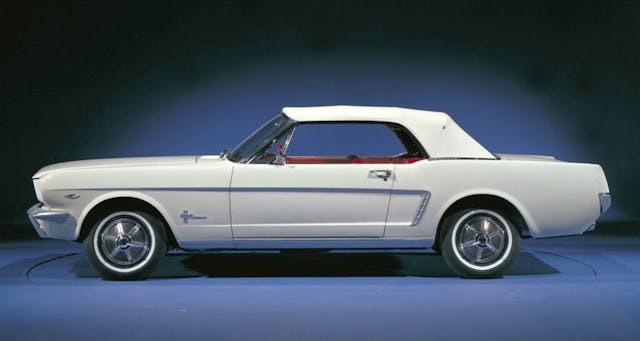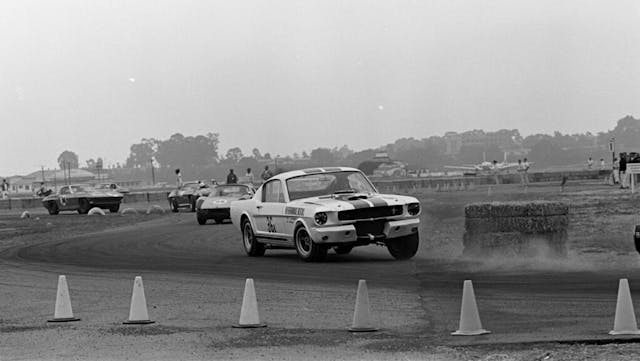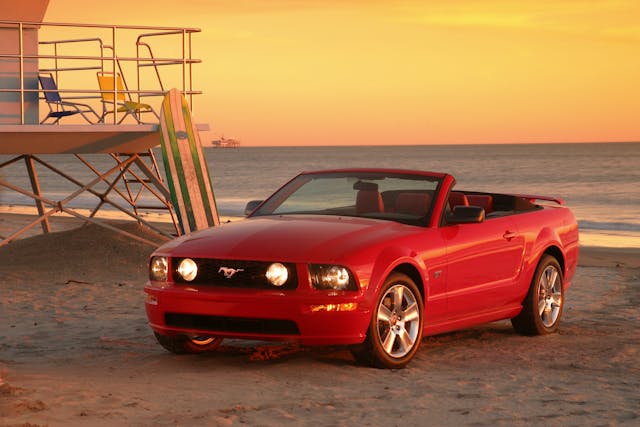The Camaro is great, but there’s no replacement for the original pony
As someone who has owned three GM pony cars, I find myself firmly in the camp that is celebrating the life of the Camaro this month. Even I admit there would be no Camaro without the Mustang, though, and Rob Sass’ opinionated musings below are a clear-eyed reminder of the root of the Camaro’s origin. Maybe, too, they are a reminder of why the car is soon disappearing. —EE
If you sensed that there was a little something special in the way the earth tilted on its axis in 2010, you probably weren’t imagining things. The original pony car got back its most bitter—and consistently credible—rivalry that year, and for more than a decade, both the Camaro and the Mustang were the better for it, continuously goading each other to reach new heights just as they did after the Camaro burst onto the scene in 1967.
As it turns out, though, the flame that burns bright also burns short—the Camaro’s Transformers–fueled revival didn’t quite make it a decade and a half, and barring some sort of misguided EV revival, the Camaro nameplate seems destined to become part of the automotive fossil record. Not so (at least not yet) for its Mustang sparring partner, and to a degree, we all know why. Storied and beloved though the Camaro is, honest enthusiasts have to acknowledge that since it was created as a response to the Mustang, it could never occupy the same hallowed space in the car-crazy American psyche as the original. Though there were several moments in their intertwined history where the Camaro came out on top, the Mustang was always the one that mattered most.
The original

Ford, and specifically one Lido Anthony Iacocca, were the first ones to do the math. 1964 marked the beginning of a tsunami for the youth market, not just for cars but for every imaginable consumer good. The postwar baby boom that had started in 1945 was poised to deliver millions of people with some actual spending power and Ford got there first with something sexy. Hell, the name of the entire segment, “pony car” was inspired by their product. GM was inexplicably—remember, this was the fearless company trying innovative concepts like the Corvair and penning some of the most beautiful cars ever, like the second-gen Corvette—and inexcusably late to the party, and that colossal error in product planning has always hung over the Camaro and its long-gone Firebird sibling.
Indelible personalities
It’s not as though there was no Camaro royalty—people like Don Yenko, Bill “Grumpy” Jenkins, Roger Penske, and Mark Donohue are all certified legends, but none could compete with the dynamic duo of self-promotion that Carroll Shelby and Lee Iacocca represented. Both are household names, well-known even outside of car enthusiast circles. Both knew that in order to secure the Mustang’s future, its success was as dependent on marketing as design and execution. More than ten years after Carroll signed the last glovebox, the legacy of the original Shelby GT350 and the Shelby name itself still loom large, while the magnificent Yenko and COPO Camaros are mainly museum pieces, important mainly to those in the know.
Mustang’s motorsports success meant more

This one comes as close to a draw as possible, as over the last 50-plus years, the Camaro has taken its share of motorsports wins over the Mustang. But the fact is, by the time Mark Donohue delivered the first Mustang spanking at the hands of his Penske Camaro, besting Parnelli Jones in the 1968 Trans Am season, the Mustang had already established its reputation as a winner—the Shelby GT350 Mustang won the SCCA B Production championship in 1965, and the Mustang took the Trans Am championship in 1967. The Falcon-based pony was firmly rooted as the athletic and fun car to have in the eyes of the American public. Once again, it pays to be the first mover.
Styling, and timing, were almost always on the Mustang’s side
Styling is subjective, but some things about the Mustang’s looks aren’t in dispute. The Mustang created the template for the pony car—long hood and short rear deck, and while the original notchback and convertible body styles were nice to look at, it was the 1965 fastback that became iconic. Chevy seemed to recognize that, abandoning the notchback design for the second-generation Camaro in 1970, producing what was arguably the prettiest Camaro ever. They managed to keep it nicely updated with a smart urethane nose that looked good even as the 1980s dawned and with Ford selling the infamous Mustang II, the Malaise Era should have been Camaro’s opportunity to crush the Mustang. Chevy did manage to eke out a couple years of sales victories as the ’70s drew to a close, but once again, GM dithered, its updated third-gen Camaro following the sharp Fox-body Mustang by three critical years. Momentum lost once again. The ’90s were a bit of a draw, with both cars suffering from the melted, jellybean, overhang-rich styling trends of the time.

History repeated itself in 2005 when Ford introduced the brilliant Sid Ramnarace–designed S-197 Mustang, which incorporated some of the best-loved design elements of the first-generation car. GM waited an excruciating five years to decide that there might be some life left in the segment after all. In 2010, almost a decade after killing the Camaro/Firebird F-body twins, GM gave us the best-performing Camaro yet, but inexplicably, it drew its stylistic inspiration from the first-generation Camaro, rather than the much prettier second-generation car. Perhaps it saw the original notchback coupe design as a way to differentiate the car from the fastback Mustang. At least to my eye, nearly every variety of post-2010 Mustang is both prettier and more distinctive than the Camaro, which suffered from a series of uninspired redesigns and mid-cycle “enhancements.” With about half as many Camaros sold as Mustangs in 2022, the buying public clearly knows what it wants.
Which brings us to today. The Camaro heads off into oblivion, or at least its second purgatory, while a brand-new generation of Mustang launches into an admittedly uncertain future. The traits the Mustang had from the get-go—first-mover advantage, performance identity, baked-in marketing mojo, big personalities, an eye for what design would resonate—all built one of the strongest-ever brands in American cars, and arguably the momentum that’s keeping the Mustang alive for another generation. That said, we’ll all miss the rivalry. Regardless of where you stand, it unquestionably made both cars better.
***
Check out the Hagerty Media homepage so you don’t miss a single story, or better yet, bookmark it. To get our best stories delivered right to your inbox, subscribe to our newsletters.



The Mustang was far from perfect. The early cars were very cheaply made. Take out the gas tank and there is no trunk. But styling was appealing and the key is women bought the 6 cylinder convertibles and coupes for years. That often is where the sales difference was.
The Mustangs that they did get better were the 69 and 70 models then they lost their way again till around 1985 the 5.0 FI Fox body hit the market.
Yeah it seems like you’re a little confused. Your article is about the original pony car but that was clearly the Plymouth Barracuda. Or do you mean for it to be about the Mustang? Because if you did then you should remove the “original” part of the headline and story.
Agree to disagree. The 1st gen Barracuda was just a slightly modified Valant, not a sporty pony car. It wasn’t until the 2nd gen with it’s unique body that it came closer to a pony car. But in reality, it wasn’t a true pony car until 1970.
I find your comment akin to people that say the GTO wasn’t the first muscle car because of the ’55 Chrysler 300 (or some other car they like more than the GTO). The muscle car was more than just a big engine in a car, it was also how it was marketed and to whom it was designed and styled for.
This article is spot on except for two things: The Barracuda was the first Pony Car, but it wasn’t that successful. If it had been, we’d call them Fish Cars!
The second point is the 5.0/Fox platform unlocked fuel injection tuning to the masses. Yes, the Chevy 350 is the penultimate shade tree hit rod motor, but the 5.0 EECS IV engine in the Fox bodied Mustangs opened the floodgates for the FI hot rod world.
Other than that, this article is spot on. A-. Good job!
That’s like saying the Camaro would be called the “buddy” car or maybe “comrade” car. The name pony came from the smaller inch engines used for the racing circuit. 302 and whatnot. They had less horsepower “ponies” than the big block cars. A Boss 429 mustang is not considered a pony car. But you’re completely correct about the FI on the later mustangs. Too bad the block couldn’t handle any serious power.
I’m a Ford fan, my first two cars were both new red Mustangs. I have basically liked them all (except for the blunt nosed late Fox-bodies).
But, the prettiest pony car ever were the early second gen Camaros…followed by early third generation F bodies.
No one in the world produced an AFFORDABLE performance car.that looked so good.
However, I never did learn to tell the differences between the 5th and 6th generation Camaros. To the uninitiated, the changes looked like a minor mid-cycle update.
Anyway, back to the Mustang… I was a kid when they were introduced, and I can recall going with my entire family to see them. It is as close as we’ll come to experiencing the furor of the introduction of the Model A…or perhaps Lindbergh’s flight the year before.
I do hope the Mustang survives as something other than an electric people box.
It may be the last reminder of when Detroit built cars for people with a passion for driving.
The early 2nd gen non-RS cars. Peak Camaro design for sure.
I like the original Mustang but I like the Camaro just as much. One can argue on “best” multiple ways. Too bad the Camaro is dead.
I’ve owned several Mustangs, several Camaros, and several Barracudas. While they of course competed against each other, and from some viewpoints were quite similar, each had its own personality. I’ve owned one or the other since the early ’70s, and still do. Nothing beats a relatively light, V8 stick car for fun. It’s tragic that they’re apparently being replaced one by one with soul-less electric appliances.
Well written and right said! Same stuff I’ve been mumbling to myself for years.
I’ve owned Mustangs, Camaros, and even a Challenger. They were all good at being cheap, entertaining transportation. I still have a 66 Fastback. Hell, even a Camry is quicker now a days but it has no soul. Wringing out a small block through a four speed will never be replaced by touch screens and launch control.
Some would say that the Corvair Monza was first at bat.
The Ford Mustang was the first “Pony” car! A pony and mustang are both names for a small horse. Cars built to compete with the Ford Mustang were called “Pony Cars” for that reason. This competition made them all better! Mustang, Camaro, Barracuda, Challenger… I love them all.
That’s a good argument to anyone that claims the Barracuda was the first pony car.
However, I would not consider the Corvair Monza the first pony car only because it based off a model that included 4-doors and wagons (and even pickups). Since the Mustang, Camaro, Barracuda, Firebird, etc were never offered as 4-doors (ignore the MACH-e), I would say a true pony car would have to be a model that was only available as a 2-door coupe or convertible.
Ok, the Barracuda was a modified Valiant, but wasn’t the Mustang a modified Falcon? Are we splitting hairs?
BTW, I own a Mustang.
The Barracuda was a Valiant with a facelift, not a different model. Similar body, grille, etc.
The Mustang was a completely different car built off the same platform/chassis as a Falcon.
It’s not splitting hairs, they are 2 different things.
The “Original Pony” was a theft of Shelby’s mustang. Ford cheated them in court. Ford has had very few original ideas since the late 50’s. Even the gt-40 was stolen from Chevrolet. After they paid the designer to quit and steal the designs and all associated paperwork.